Performance Analysis of Interconnection and Differential Power Processing Techniques under Partial Shading Conditions
Abstract
1. Introduction
2. Materials and Methods
2.1. General Proceedings
2.2. Specific Proceedings
3. Results and Discussion
3.1. P-V Curves
3.2. Shading Patterns
3.2.1. High-Irradiance Shading (700 W/m2)
3.2.2. Low-Irradiance Shading (400 W/m2)
3.3. Performance Indicators
3.3.1. Performance Ratio
3.3.2. Mismatch Power Loss
3.3.3. Power Enhancement
4. Conclusions
Supplementary Materials
Author Contributions
Funding
Data Availability Statement
Conflicts of Interest
References
- Witteck, R.; Siebert, M.; Blankemeyer, S.; Schulte-Huxel, H.; Kontges, M. Three Bypass Diodes Architecture at the Limit. IEEE J. Photovolt. 2020, 10, 1828–1838. [Google Scholar] [CrossRef]
- Xenophontos, A.; Bazzi, A.M. Model-Based Maximum Power Curves of Solar Photovoltaic Panels under Partial Shading Conditions. IEEE J. Photovolt. 2018, 8, 233–238. [Google Scholar] [CrossRef]
- Bingöl, O.; Özkaya, B. Analysis and Comparison of Different PV Array Configurations under Partial Shading Conditions. Sol. Energy 2018, 160, 336–343. [Google Scholar] [CrossRef]
- Singh, R.; Yadav, V.K.; Singh, M. An Improved Hot Spot Mitigation Approach for Photovoltaic Modules under Mismatch Conditions. IEEE Trans. Ind. Electron. 2024, 71, 4840–4850. [Google Scholar] [CrossRef]
- Changmai, P.; Metya, S.K. Determination of the Best Shading Pattern to Maximize the Power of TCT Connected Solar PV Array during Partial Shading Condition. J. Opt. 2019, 48, 499–504. [Google Scholar] [CrossRef]
- Ghosh, S.; Singh, S.K.; Yadav, V.K. Experimental Investigation of Hotspot Phenomenon in PV Arrays under Mismatch Conditions. Sol. Energy 2023, 253, 219–230. [Google Scholar] [CrossRef]
- Belhaouas, N.; Mehareb, F.; Assem, H.; Kouadri-Boudjelthia, E.; Bensalem, S.; Hadjrioua, F.; Aissaoui, A.; Bakria, K. A New Approach of PV System Structure to Enhance Performance of PV Generator under Partial Shading Effect. J. Clean. Prod. 2021, 317, 128349. [Google Scholar] [CrossRef]
- Li, C.; Yang, Y.; Zhang, K.; Zhu, C.; Wei, H. A Fast MPPT-Based Anomaly Detection and Accurate Fault Diagnosis Technique for PV Arrays. Energy Convers. Manag. 2021, 234, 113950. [Google Scholar] [CrossRef]
- Karmakar, B.K.; Pradhan, A.K. Detection and Classification of Faults in Solar PV Array Using Thevenin Equivalent Resistance. IEEE J. Photovolt. 2020, 10, 644–654. [Google Scholar] [CrossRef]
- Bhadoria, V.S.; Pachauri, R.K.; Tiwari, S.; Jaiswal, S.P.; Alhelou, H.H. Investigation of Different BPD Placement Topologies for Shaded Modules in a Series-Parallel Configured PV Array. IEEE Access 2020, 8, 216911–216921. [Google Scholar] [CrossRef]
- Fang, X.; Yang, Q. Dynamic Reconfiguration of Photovoltaic Array for Minimizing Mismatch Loss. Renew. Sustain. Energy Rev. 2024, 191, 114160. [Google Scholar] [CrossRef]
- Suresh Kumar, K.; Winston David, P. Performance Analysis of Winnowing Dynamic Reconfiguration in Partially Shaded Solar Photovoltaic System. Sol. Energy 2024, 268, 112309. [Google Scholar] [CrossRef]
- Oufettoul, H.; Motahhir, S.; Ait Abdelmoula, I.; Aniba, G. Optimized Topology for a Photovoltaic Array Using Switches Control. Energy Convers. Manag. 2023, 291, 117315. [Google Scholar] [CrossRef]
- Manjunath; Suresh, H.N.; Rajanna, S.; Thanikanti, S.B.; Alhelou, H.H. Hybrid Interconnection Schemes for Output Power Enhancement of Solar Photovoltaic Array under Partial Shading Conditions. IET Renew. Power Gen. 2022, 16, 2859–2880. [Google Scholar]
- Madhu, G.M.; Vyjayanthi, C.; Modi, C.N. Investigation on Effect of Irradiance Change in Maximum Power Extraction from PV Array Interconnection Schemes during Partial Shading Conditions. IEEE Access 2021, 9, 96995–97009. [Google Scholar] [CrossRef]
- Sai Krishna, G.; Moger, T. Investigation of Power Losses on Solar Photovoltaic Array Interconnections under Mismatch Conditions. Technol. Econ. Smart Grids Sustain. Energy 2021, 6, 22. [Google Scholar] [CrossRef]
- Satpathy, P.R.; Jena, S.; Sharma, R. Power Enhancement from Partially Shaded Modules of Solar PV Arrays through Various Interconnections among Modules. Energy 2018, 144, 839–850. [Google Scholar] [CrossRef]
- Vinnikov, D.; Chub, A.; Liivik, E.; Kosenko, R.; Korkh, O. Solar Optiverter—A Novel Hybrid Approach to the Photovoltaic Module Level Power Electronics. IEEE Trans. Ind. Electron. 2019, 66, 3869–3880. [Google Scholar] [CrossRef]
- Ramli, M.Z.; Salam, Z. Performance Evaluation of Dc Power Optimizer (DCPO) for Photovoltaic (PV) System during Partial Shading. Renew. Energy 2019, 139, 1336–1354. [Google Scholar] [CrossRef]
- Adly, M.; Strunz, K. Irradiance-Adaptive PV Module Integrated Converter for High Efficiency and Power Quality in Standalone and DC Microgrid Applications. IEEE Trans. Ind. Electron. 2018, 65, 436–446. [Google Scholar] [CrossRef]
- Nazer, A.; Manganiello, P.; Isabella, O. A Virtual Bus Parallel Differential Power Processing Configuration for Photovoltaic Applications. Math. Comput. Simul. 2024, 224, 49–62. [Google Scholar] [CrossRef]
- Sundaram, B.M.; Manikandan, B.V.; Praveen Kumar, B.; Prince Winston, D. Combination of Novel Converter Topology and Improved MPPT Algorithm for Harnessing Maximum Power from Grid Connected Solar PV Systems. J. Electr. Eng. Technol. 2019, 14, 733–746. [Google Scholar] [CrossRef]
- Lee, H.; Kim, K. Design Considerations for Parallel Differential Power Processing Converters in a Photovoltaic-Powered Wearable Application. Energies 2018, 11, 3329. [Google Scholar] [CrossRef]
- Wang, X.; Wen, H.; Chu, G.; Zhu, Y.; Yang, Y.; Wang, Y.; Jiang, L. Performance Quantization and Comparative Assessment of Voltage Equalizers in Mismatched Photovoltaic Differential Power Processing Systems. IEEE Trans. Power Electron. 2024, 39, 1656–1675. [Google Scholar] [CrossRef]
- Meira Amaral Da Luz, C.; Moreira Vicente, E.; Lessa Tofoli, F.; Roberto Ribeiro, E. Differential Power Processing Architecture to Increase Energy Harvesting of Photovoltaic Systems under Permanent Mismatch. Sol. Energy 2023, 263, 111940. [Google Scholar] [CrossRef]
- Uno, M.; Liu, X.; Sato, H.; Saito, Y. Panel-to-Substring PWM Differential Power Processing Converter and Its Maximum Power Point Tracking Technique for Solar Roof of Plug-In Electric Vehicles. IEEE Access 2022, 10, 42883–42896. [Google Scholar] [CrossRef]
- Pannebakker, B.B.; De Waal, A.C.; Van Sark, W.G.J.H.M. Photovoltaics in the Shade: One Bypass Diode per Solar Cell Revisited. Prog. Photovolt. Res. Appl. 2017, 25, 836–849. [Google Scholar] [CrossRef]
- Saeed, F.; Tauqeer, H.A.; Gelani, H.E.; Yousuf, M.H.; Idrees, A. Numerical Modeling, Simulation and Evaluation of Conventional and Hybrid Photovoltaic Modules Interconnection Configurations under Partial Shading Conditions. EPJ Photovolt. 2022, 13, 10. [Google Scholar] [CrossRef]
- Satpathy, P.R.; Babu, T.S.; Shanmugam, S.K.; Popavath, L.N.; Alhelou, H.H. Impact of Uneven Shading by Neighboring Buildings and Clouds on the Conventional and Hybrid Configurations of Roof-Top PV Arrays. IEEE Access 2021, 9, 139059–139073. [Google Scholar] [CrossRef]
- Bana, S.; Saini, R.P. Experimental Investigation on Power Output of Different Photovoltaic Array Configurations under Uniform and Partial Shading Scenarios. Energy 2017, 127, 438–453. [Google Scholar] [CrossRef]
- Nnamchi, S.N.; Oko, C.O.C.; Kamen, F.L.; Sanya, O.D. Mathematical Analysis of Interconnected Photovoltaic Arrays under Different Shading Conditions. Cogent Eng. 2018, 5, 1507442. [Google Scholar] [CrossRef]
- Agrawal, N.; Bora, B.; Kapoor, A. Experimental Investigations of Fault Tolerance Due to Shading in Photovoltaic Modules with Different Interconnected Solar Cell Networks. Sol. Energy 2020, 211, 1239–1254. [Google Scholar] [CrossRef]
- Alves, T.; N. Torres, J.P.; Marques Lameirinhas, R.A.; F. Fernandes, C.A. Different Techniques to Mitigate Partial Shading in Photovoltaic Panels. Energies 2021, 14, 3863. [Google Scholar] [CrossRef]
- Natarajan, B.; Murugesan, P.; Udugula, M.; Gurusamy, M.; Subramaniam, S. A Fixed Interconnection Technique of Photovoltaic Modules Using a Sensorless Approach for Maximum Power Enhancement in Solar Plants. Energy Sources Part A 2020, 1–23. [Google Scholar] [CrossRef]
- Shao, C.; Migan-Dubois, A.; Diallo, D. Performance of PV Array Configurations under Dynamic Partial Shadings. EPJ Photovolt. 2023, 14, 21. [Google Scholar] [CrossRef]
- Jeong, H.; Lee, H.; Liu, Y.-C.; Kim, K.A. Review of Differential Power Processing Converter Techniques for Photovoltaic Applications. IEEE Trans. Energy Convers. 2019, 34, 351–360. [Google Scholar] [CrossRef]
- Jiang, J.; Zhang, T.; Chen, D. Analysis, Design, and Implementation of a Differential Power Processing DMPPT with Multiple Buck–Boost Choppers for Photovoltaic Module. IEEE Trans. Power Electron. 2021, 36, 10214–10223. [Google Scholar] [CrossRef]
- Jeon, Y.-T.; Park, J.-H. Unit-Minimum Least Power Point Tracking for the Optimization of Photovoltaic Differential Power Processing Systems. IEEE Trans. Power Electron. 2019, 34, 311–324. [Google Scholar] [CrossRef]
- Gokdag, M.; Akbaba, M.; Gulbudak, O. Switched-Capacitor Converter for PV Modules under Partial Shading and Mismatch Conditions. Sol. Energy 2018, 170, 723–731. [Google Scholar] [CrossRef]
- Gnanavadivel, J.; Kalarathi, M.; Prakash, K. Analysis of Single Switch Step Up DC-DC Converter with Switched Inductor-Switched Capacitor Cells for PV System. IJAPE 2024, 13, 20. [Google Scholar] [CrossRef]
- Mi, J.; Du, J.; Liu, C.; Li, X.; Zhang, Y.; Fan, G. Design and Optimization of Photovoltaic System in Full-Chain Ground-Based Validation System of Space Solar Power Station. Energies 2023, 16, 3247. [Google Scholar] [CrossRef]
- Niazi, K.A.K.; Yang, Y.; Nasir, M.; Sera, D. Evaluation of Interconnection Configuration Schemes for PV Modules with Switched-Inductor Converters under Partial Shading Conditions. Energies 2019, 12, 2802. [Google Scholar] [CrossRef]
- Wang, X.; Wen, H.; Chu, G.; Zhou, J. Cost-Effective and Extensible LLC-Resonant Voltage-Multiplier-Based Differential Power Processing Optimizer for Mismatched Photovoltaic Systems. Sol. Energy 2021, 225, 501–516. [Google Scholar] [CrossRef]
- Xu, D.; Chen, H.; Wang, X.; Pires, V.; Martins, J.; Anuchin, A.; Li, X.; Palka, R.; Gu, J. Coupling Analysis of Differential Power Processing-Based PV System and Its Decoupling Implementation of Synchronous MPPT Control. IEEE Trans. Ind. Electron. 2023, 70, 6973–6983. [Google Scholar] [CrossRef]
- Uno, M.; Kukita, A. Current Sensorless Equalization Strategy for a Single-Switch Voltage Equalizer Using Multistacked Buck–Boost Converters for Photovoltaic Modules under Partial Shading. IEEE Trans. Ind. Appl. 2017, 53, 420–429. [Google Scholar] [CrossRef]
- Meira Amaral Da Luz, C.; Roberto Ribeiro, E.; Lessa Tofoli, F. Analysis of the PV-to-PV Architecture with a Bidirectional Buck-Boost Converter under Shading Conditions. Sol. Energy 2022, 232, 102–119. [Google Scholar] [CrossRef]
- Liu, C.; Zheng, Y.; Lehman, B. PV Panel to PV Panel Transfer Method for Modular Differential Power Processing. IEEE Trans. Power Electron. 2022, 37, 4764–4778. [Google Scholar] [CrossRef]
- Etarhouni, M.; Chong, B.; Zhang, L. A Combined Scheme for Maximising the Output Power of a Photovoltaic Array under Partial Shading Conditions. Sustain. Energy Technol. Assess. 2022, 50, 101878. [Google Scholar] [CrossRef]
- Murkute, S.; Kulkarni (Deodhar), V.A. New High Performance PV System Architecture for Mitigation of Partial Shading Effects. e-Prime Adv. Electr. Eng. Electron. Energy 2023, 5, 100189. [Google Scholar] [CrossRef]
- Cubas, J.; Pindado, S.; Victoria, M. On the Analytical Approach for Modeling Photovoltaic Systems Behavior. J. Power Sources 2014, 247, 467–474. [Google Scholar] [CrossRef]
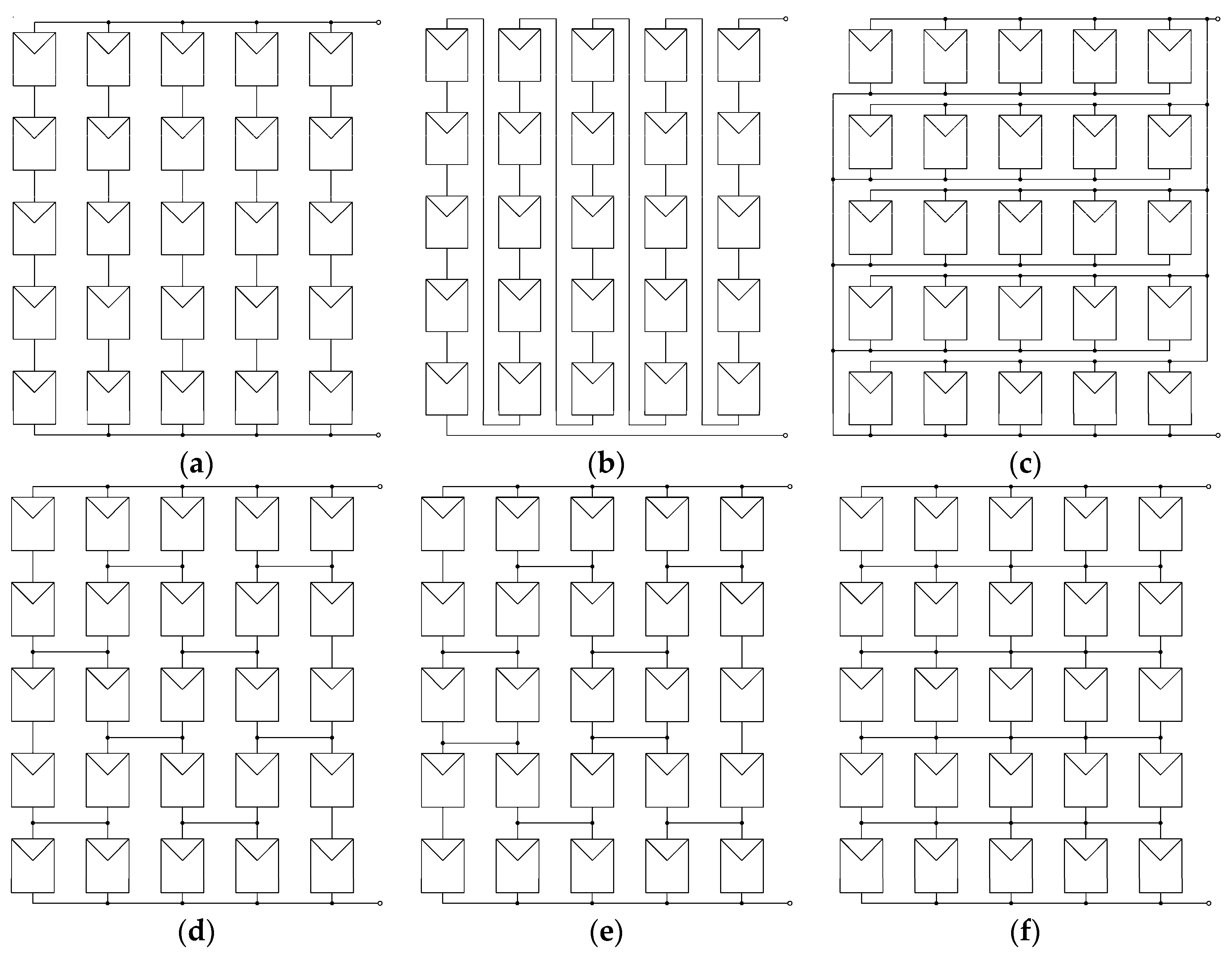

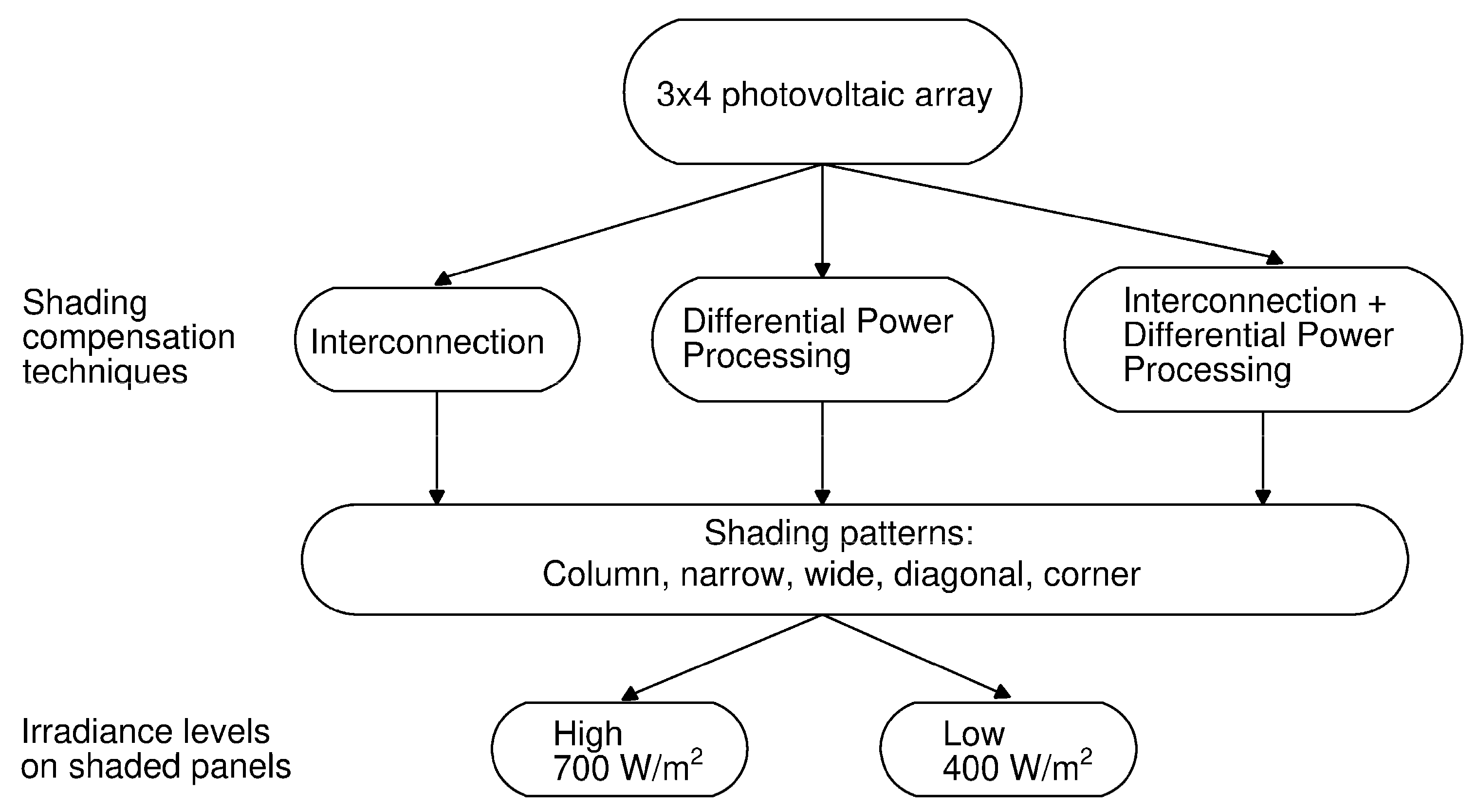

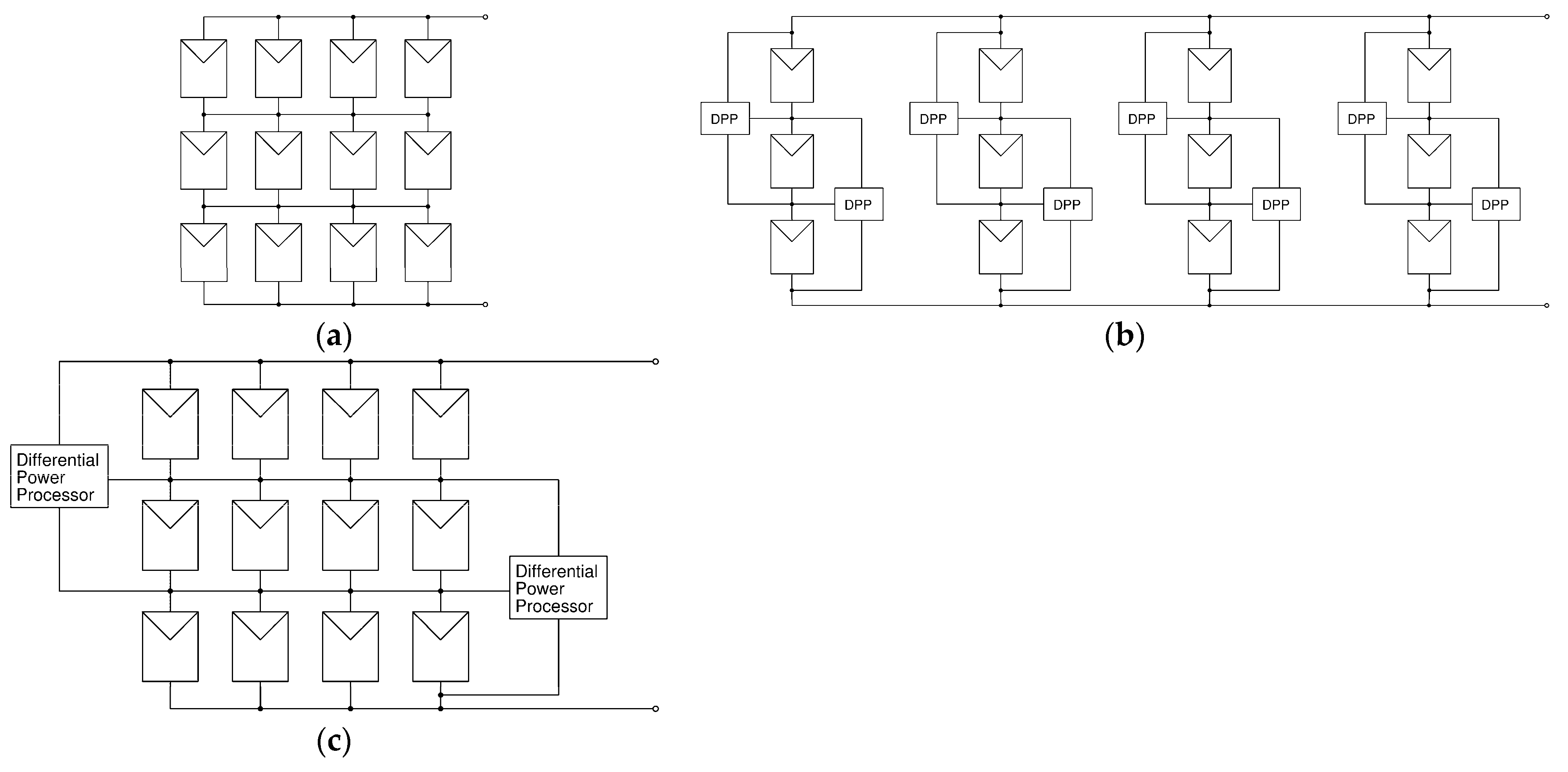

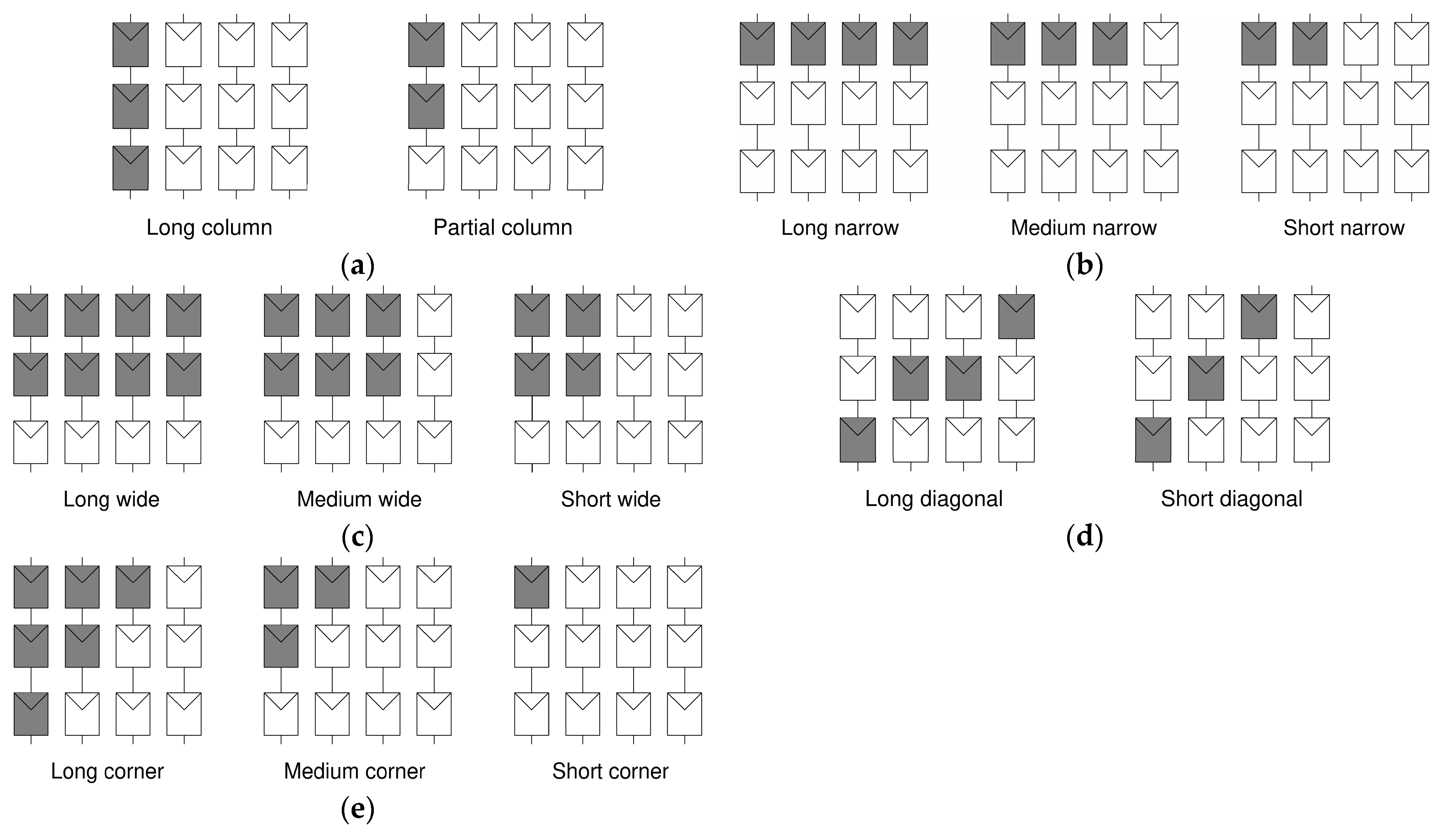
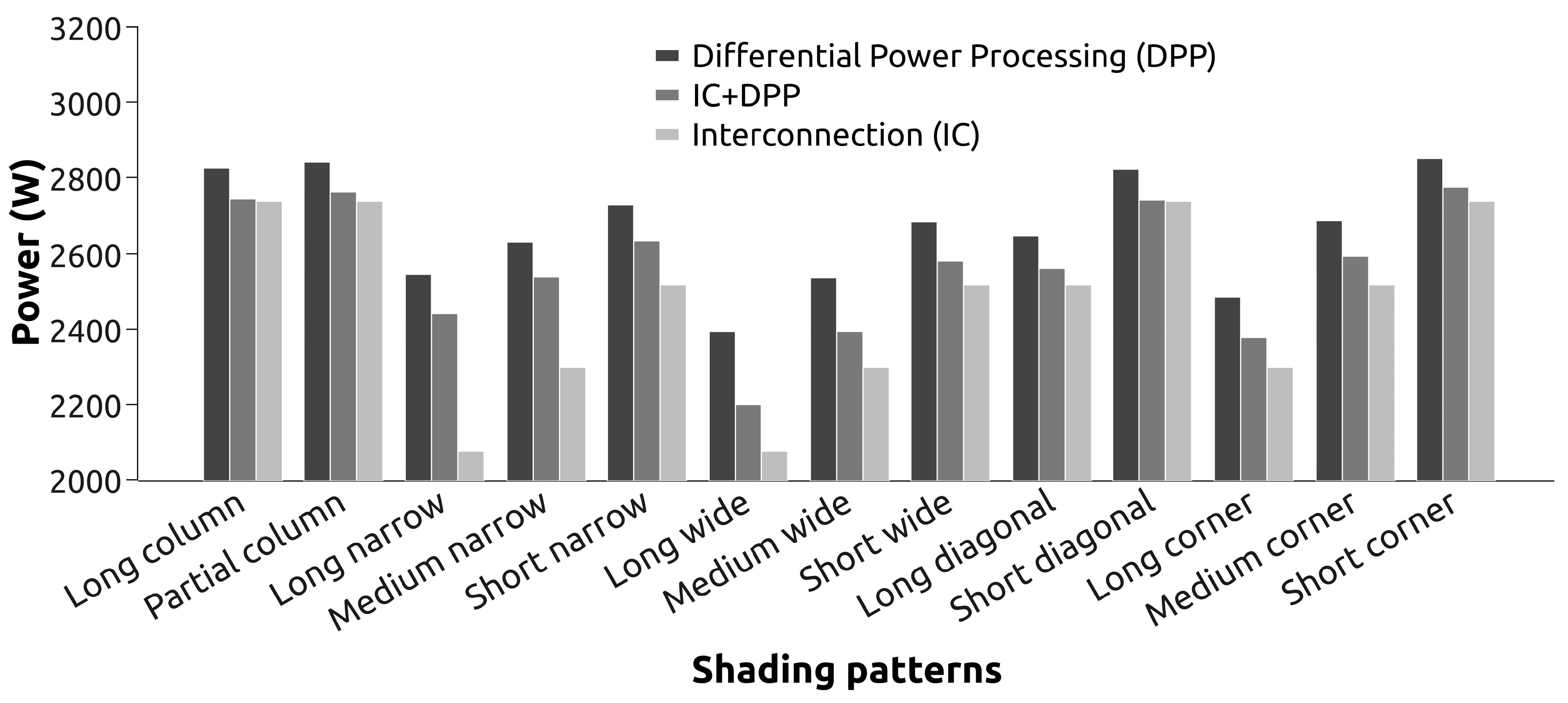
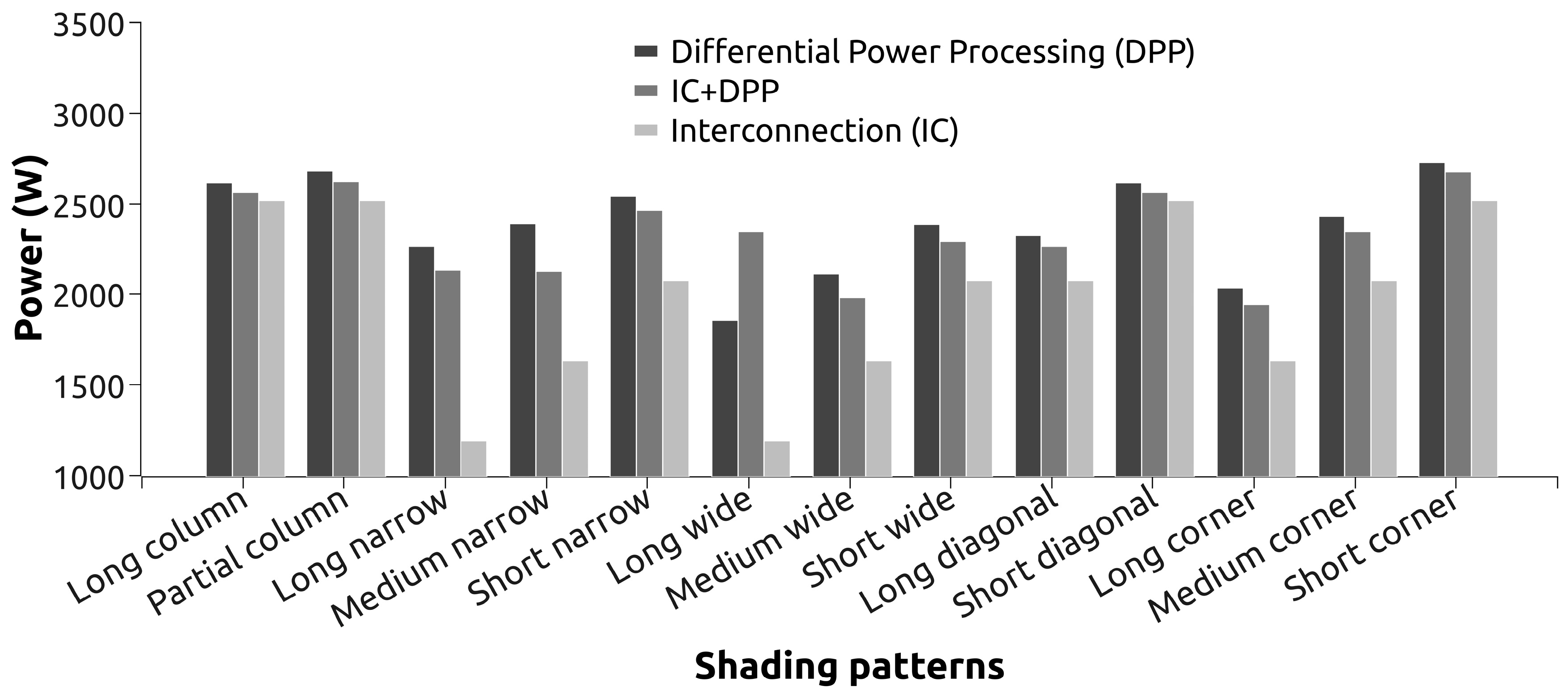


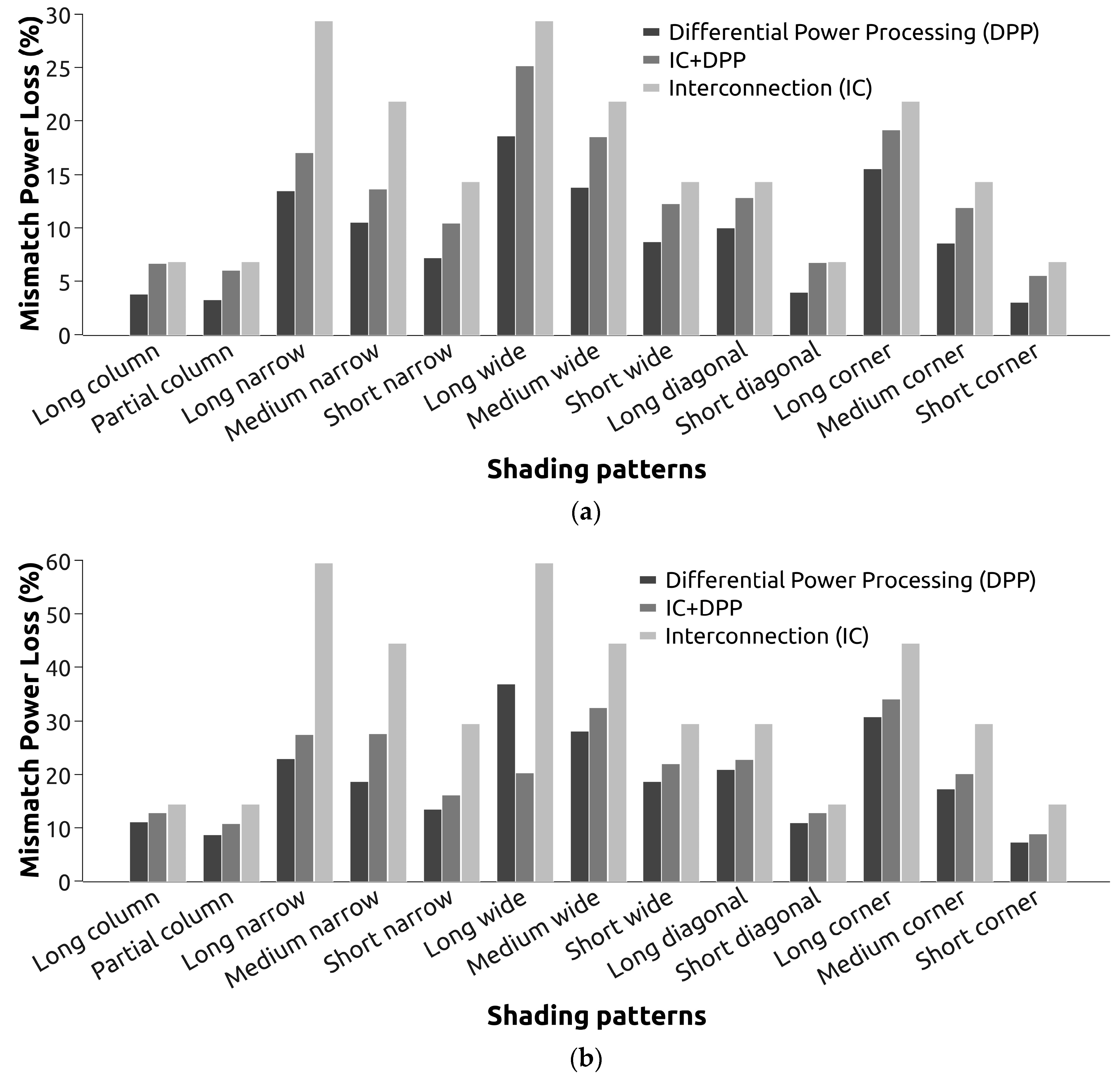
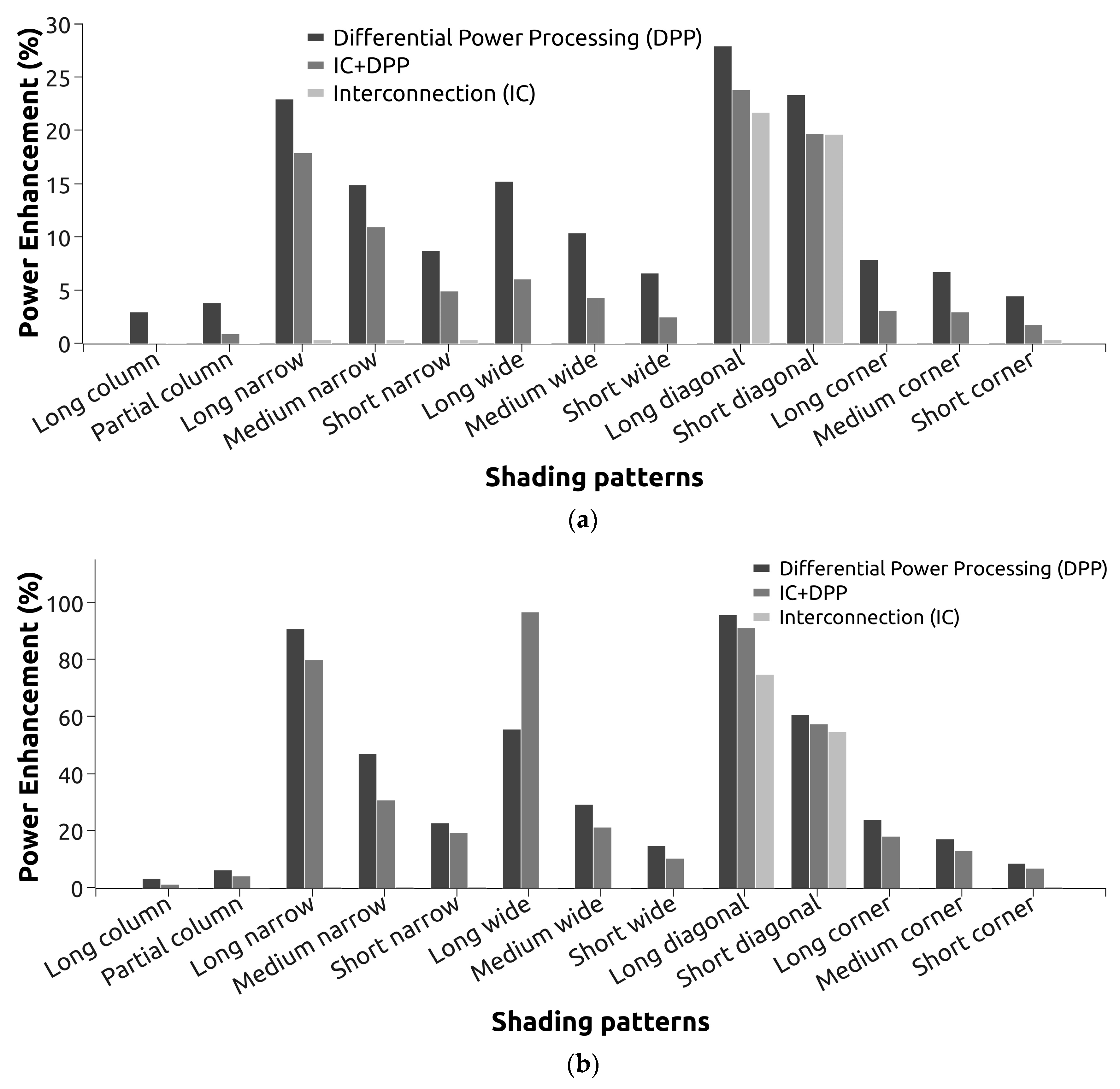
| Characteristic | Value |
|---|---|
| Manufacturer | Yingli Solar |
| Model | YL245-29b |
| Cell type | Multicrystalline |
| Number of cells | 60 |
| Maximum power (PMP) | 245 Wp |
| Open-circuit voltage (VOC) | 37.8 V |
| Short-circuit current (ISC) | 8.63 A |
| Voltage at PMP (VMP) | 30.2 V |
| Current at PMP (IMP) | 8.11 A |
| Temperature coefficient of VOC | −0.33%/°C |
| Temperature coefficient of ISC | 0.06%/°C |
Disclaimer/Publisher’s Note: The statements, opinions and data contained in all publications are solely those of the individual author(s) and contributor(s) and not of MDPI and/or the editor(s). MDPI and/or the editor(s) disclaim responsibility for any injury to people or property resulting from any ideas, methods, instructions or products referred to in the content. |
© 2024 by the authors. Licensee MDPI, Basel, Switzerland. This article is an open access article distributed under the terms and conditions of the Creative Commons Attribution (CC BY) license (https://creativecommons.org/licenses/by/4.0/).
Share and Cite
Gouvêa, E.C.; Castro, T.S.; de Souza, T.M. Performance Analysis of Interconnection and Differential Power Processing Techniques under Partial Shading Conditions. Energies 2024, 17, 3252. https://doi.org/10.3390/en17133252
Gouvêa EC, Castro TS, de Souza TM. Performance Analysis of Interconnection and Differential Power Processing Techniques under Partial Shading Conditions. Energies. 2024; 17(13):3252. https://doi.org/10.3390/en17133252
Chicago/Turabian StyleGouvêa, Evaldo Chagas, Thais Santos Castro, and Teófilo Miguel de Souza. 2024. "Performance Analysis of Interconnection and Differential Power Processing Techniques under Partial Shading Conditions" Energies 17, no. 13: 3252. https://doi.org/10.3390/en17133252
APA StyleGouvêa, E. C., Castro, T. S., & de Souza, T. M. (2024). Performance Analysis of Interconnection and Differential Power Processing Techniques under Partial Shading Conditions. Energies, 17(13), 3252. https://doi.org/10.3390/en17133252






